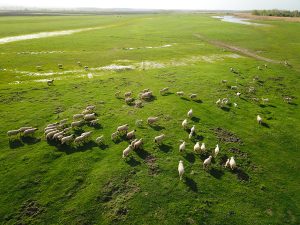The South African merino clip, in greasy terms, is around 12% of the size of the Australian merino clip. However “wools ain’t wools”, so in some categories South African wool dominates supply. This article takes a look at South African merino production in 2022-2023.
Regular market reports and supply analysis of the South African wool market is available on the excellent Cape Wools website (see here). Last season the Australian merino clip, using a mix of AWTA core test volumes and auction breed proportions for different micron categories for calculations, was 1.51 million farm bales out of a total clip of 1.95 million bales, with 1.27 million merino bales sold at auction. By these numbers, merino accounted for 77% of Australian wool production. In South Africa the merino clip accounts for about 60% of the greasy volume of wool (around 152,000 Australian farm bale equivalents). So the South African merino clip was 10% of the size of the Australian merino clip (and a slightly higher 12% when compared to auction sales only).
In terms of quality, the South African merino clip averaged 19.4-19.5 micron compared to the Australian merino clip which averages 18.75 micron. Figure 1 compares South African and Australian merino volumes in greasy terms in the micron categories reported by Cape Wools. As the South African clip is three-quarters of a micron broader, volumes under 18 micron fall away in comparison to Australia. South African wool remains relatively high on the broader side of production. For each micron category, the proportion of South African production to Australian is shown, peaking at 17% for 19.5 micron.
In Figure 2 the merino-micron distributions for South Africa and Australia have been estimated using a normal distribution, and then allocated across half-micron categories from 15.0 to 25.0 micron. This shows clearly the broader skew of the South African clip, with a clear lack of sub-18 micron production.
While the fibre diameter distribution of the two clips is similar, the marked difference in quality is in staple length. Figure 3 shows the distribution of merino production by staple length for each clip, in 10 mm greasy staple length increments, with the proportion of the South African production compared to the Australian production shown for each length interval. 60-70 mm are the key staple lengths for South Africa, whereas in Australia it is 90-100 mm. At 50 mm the South African production is 48% that of Australia, while they have very little that is longer than 80 mm.
The other area of difference in quality is mulesing and accreditation to quality schemes. The South African clip is non-mulesed and some 47% of the clip sold in 2022-23 was accredited, mainly, to RWS. Figure 4 compares, by micron, the volume of South African merino volumes to Australia in total, to Australian CM-NM volumes and then the quality scheme accredited volume to Australian RWS volumes. In terms of CM-NM wool the South African supply is greater than the Australian supply for 19 through 21.5 micron. In terms of RWS-accredited wool South African supply ranges from a low 150% of Australian supply for 18.5 (and 24) micron to 300% for 21 micron and much higher on the low volume very broad merino categories. This should provide some cause for consideration for the pundits that wax lyrically about the Australian wool clip being the best in the world.
What does it mean?
Wool production in other countries is often cast as competition for Australian wool growers. Given the size of the industry, it seems a better idea to view these regions as fellow producers of a larger, international merino clip. This is how the supply chain will look at greasy wool supply.
In detailed terms, the South African merino clip is a major supplier of particular categories of wool, some of which are well in excess of Australian production. In some aspects of quality, the South African clip outperforms the Australian clip which should be food for thought for the Australian merino industry.
Have any questions or comments?
Key Points
- The South African merino clip is 12% of the size of the Australian merino clip, around three-quarters of a micron broader and appreciably shorter in staple length.
- Despite being a much smaller clip, the South African clip in non-mulesed terms is three-quarters the size of the Australian CM-NM supply and matches the Australian volume for RWS wool.
Click on figure to expand
Click on figure to expand
Click on figure to expand
Click on figure to expand
Data sources: Cape Wools, AWEX, ICS, Mecardo
















